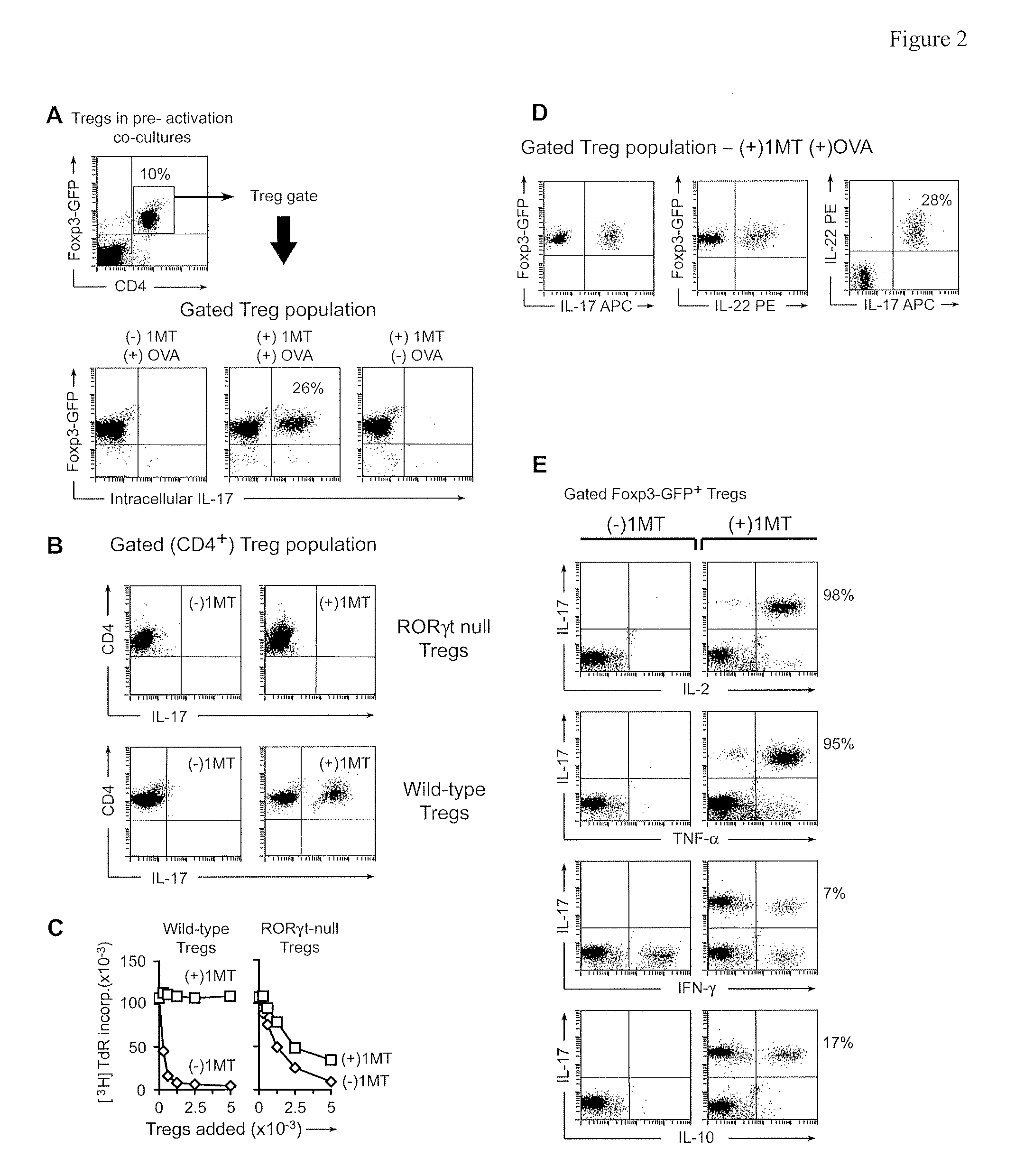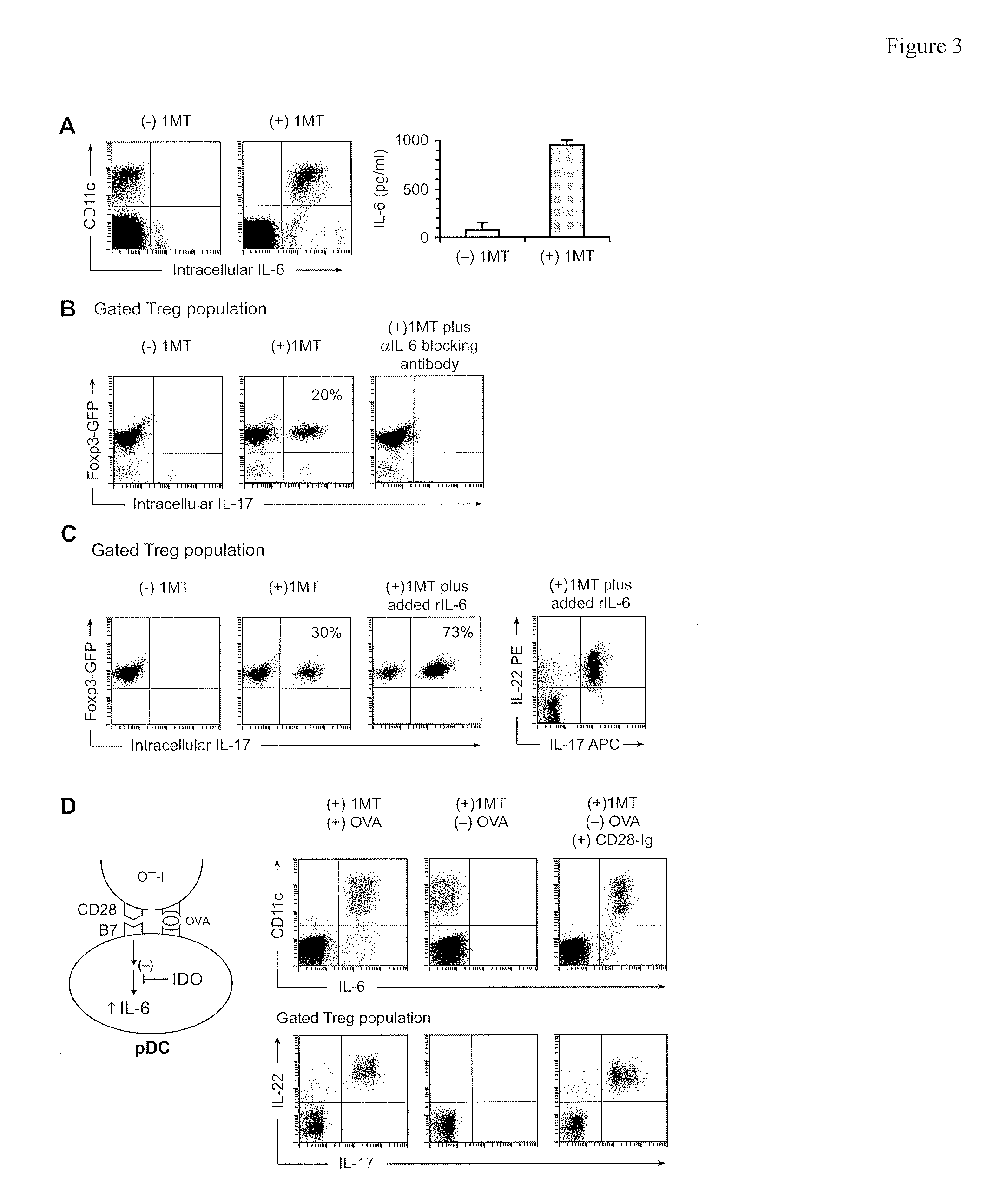Methods and compositions to enhance vaccine efficacy by reprogramming regulatory t cells
a technology of regulatory t cells and compositions, applied in the direction of drug compositions, immunological disorders, antibody medical ingredients, etc., can solve the problems of unknowable whether, difficult elimination of t cells, significant degree of phenotypic plasticity,
- Summary
- Abstract
- Description
- Claims
- Application Information
AI Technical Summary
Problems solved by technology
Method used
Image
Examples
example 1
IDO Plus Effector T Cells Activate Foxp3+ Tregs for Suppression
[0110]In vitro studies were performed using the co-culture system shown in FIG. 1A (described in Methods, from ref (Sharma, et al., (2007) “Plasmacytoid dendritic cells from mouse tumor-draining lymph nodes directly activate mature Tregs via indoleamine, 2-3-dioxygenase,” J. Clin. Invest., 117:1147-1154)). Resting Tregs (CD4+ CD25+) were sorted from spleens of B6 mice without tumors. IDO-expressing pDCs were enriched (CD11c+B220+) from the TDLNs of mice with B16 melanoma tumors. As a source of activated effector T cells, OVA-specific OT-1 T cells (sorted CD8 f) were added to co-cultures with cognate OVA peptide antigen. After 2 days, Tregs were recovered from co-cultures by FACS sorting and tested for suppressor activity in a readout assay comprising allogeneic A1 T cells (TCR-tg, recognizing a peptide of HY) plus congenic CBA spleen DCs.
[0111]FIG. 1A shows that IDO-activated Tregs acquired efficient suppressor activity....
example 2
In the Absence of IDO, Tregs Undergo Conversion to a TH17-Like Phenotype
[0113]A key point not elucidated by the preceding experiments was the fate of those Tregs exposed to activated OT-I cells but without the signal from IDO. It is known that under certain proinflammatory conditions Tregs can lose their suppressor phenotype. T helper 17 (TH17) cells bear a reciprocal developmental relationship to inducible Tregs and some Tregs that lose their suppressive phenotype may upregulate IL-17. Therefore, we asked whether Tregs exposed to activated OT-I in the absence of IDO might convert to a phenotype resembling TH17 cells.
[0114]Tregs were FACS-sorted from mice bearing a Foxp3-GFP fusion protein in place of one normal Foxp3 gene. Sorted CD4+GFP+ cells from these mice were thus unambiguously known to be Foxp3+ Tregs at the start of the assay. Pre-activation co-cultures were performed as in FIG. 1, with or without OVA and D1MT. After 2 days co-cultures were harvested and stained for intrace...
example 3
Upregulation of IL-17 in Tregs is Driven by IL-6
[0119]IL-6 is a proinflammatory cytokine that, in conjunction with TGFβ, can drive the differentiation of naive CD4+ T cells toward the TH17 lineage. Under certain conditions, IL-6 can be produced by activated pDCs, so we asked whether pDCs from TDLNs produced IL-6 in our co-cultures (FIG. 3A). For these studies, the feeder layers in co-cultures were depleted of macrophages (a potential contaminating source of IL-6). IL-17 upregulation in Tregs was unaffected by macrophage depletion, and essentially all of the IL-6-producing cells under these conditions were the pDCs (identified as CD11c+ in the FACS plots). IL-6 was expressed only when IDO was blocked with D1MT; if IDO was enzymatically active then IL-6 was suppressed. The suppressive effect of IDO was further confirmed by measuring IL-6 in co-culture supernatants by ELISA (FIG. 3A, right-hand panel)
[0120]To test whether IL-6 was mechanistically required for upregulation of IL-17 we u...
PUM
| Property | Measurement | Unit |
|---|---|---|
| Treg plasticity | aaaaa | aaaaa |
| phenotypic plasticity | aaaaa | aaaaa |
| volume | aaaaa | aaaaa |
Abstract
Description
Claims
Application Information
 Login to View More
Login to View More - R&D
- Intellectual Property
- Life Sciences
- Materials
- Tech Scout
- Unparalleled Data Quality
- Higher Quality Content
- 60% Fewer Hallucinations
Browse by: Latest US Patents, China's latest patents, Technical Efficacy Thesaurus, Application Domain, Technology Topic, Popular Technical Reports.
© 2025 PatSnap. All rights reserved.Legal|Privacy policy|Modern Slavery Act Transparency Statement|Sitemap|About US| Contact US: help@patsnap.com



